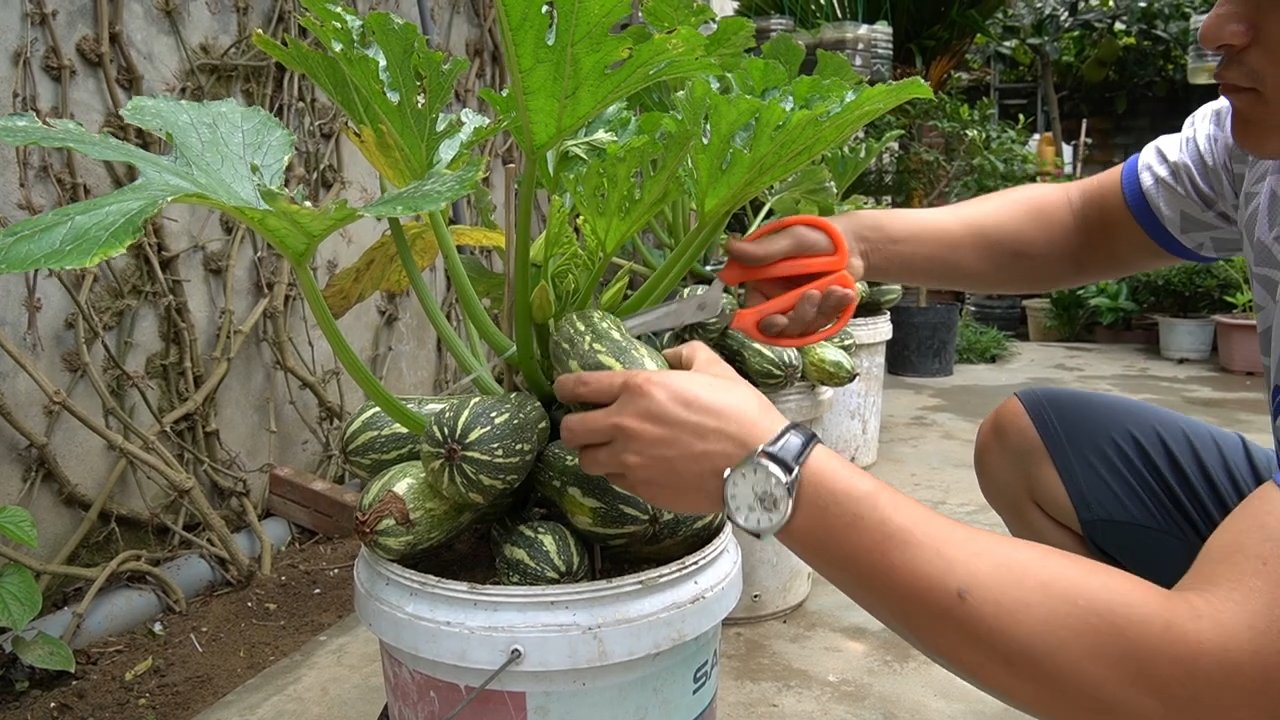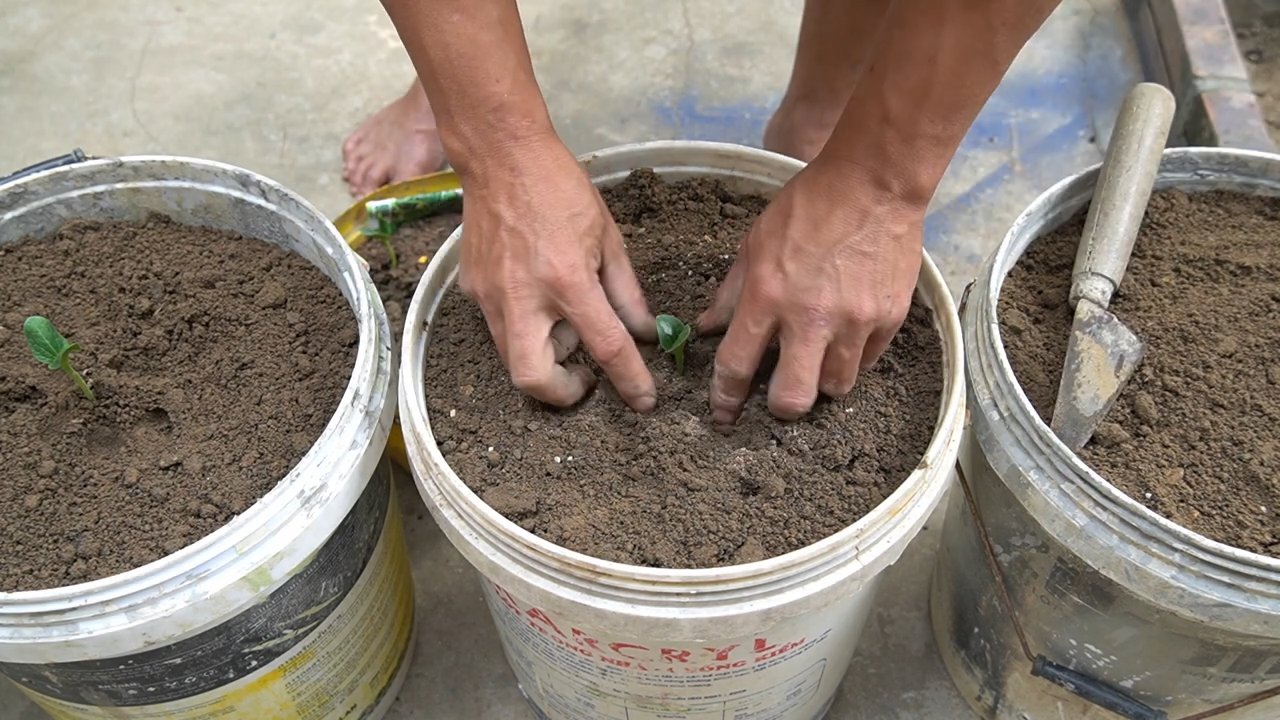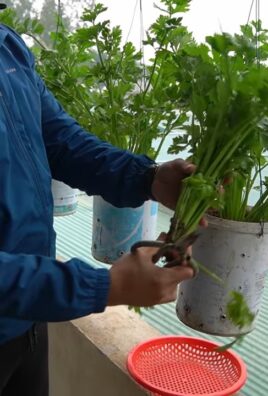Grow Zucchini in Containers? Absolutely! Imagine stepping onto your patio and harvesting fresh, vibrant zucchini right from your own container garden. No sprawling garden beds needed! For centuries, container gardening has allowed people, especially those in urban environments, to connect with nature and cultivate their own food. From the hanging gardens of Babylon to the window boxes of Parisian apartments, the desire to nurture plants in limited spaces is deeply ingrained in human history.
But why should *you* specifically learn how to grow zucchini in containers? Well, let’s face it, zucchini from the store just doesn’t compare to the flavor of homegrown. Plus, zucchini plants are notorious for their prolific production – one or two plants can provide you with a bounty of delicious vegetables all summer long! This DIY guide will walk you through every step, from choosing the right container and soil to preventing common pests and diseases. I’ll share my tried-and-true tips and tricks to ensure you have a thriving zucchini harvest, even if you’re short on space. Get ready to enjoy fresh zucchini bread, grilled zucchini skewers, and so much more, all thanks to your own container garden!

Growing Zucchini in Containers: A Comprehensive Guide
Hey there, fellow gardening enthusiasts! I’m so excited to share my experience with growing zucchini in containers. It’s totally doable, even if you don’t have a sprawling backyard. I’ve had some amazing harvests using this method, and I’m confident you can too. Let’s dive in!
Choosing the Right Container and Variety
Before we get our hands dirty, let’s talk about the essentials: the container and the zucchini variety. These choices will significantly impact your success.
* Container Size: This is crucial! Zucchini plants are vigorous growers and need plenty of space for their roots. I recommend a container that’s at least 24 inches in diameter and 24 inches deep. The bigger, the better, honestly. Think large pots, half whiskey barrels, or even sturdy grow bags.
* Drainage: Excellent drainage is non-negotiable. Zucchini hates soggy roots. Make sure your container has plenty of drainage holes. If not, you can drill some yourself.
* Container Material: Plastic, terracotta, or wood – it’s really up to you. Terracotta looks beautiful but dries out faster, so you’ll need to water more frequently. Plastic retains moisture better but can overheat in direct sunlight. Wood is a good compromise, but make sure it’s treated to prevent rot.
* Zucchini Variety: Compact or bush varieties are your best bet for container gardening. They take up less space and are generally more manageable. Some of my favorites include:
* Black Beauty: A classic, reliable variety with dark green, glossy fruits.
* Bush Baby: A very compact variety, perfect for smaller spaces.
* Eight Ball: Produces round, ball-shaped zucchini, which are fun and easy to harvest.
* Gold Rush: A beautiful golden zucchini that adds a pop of color to your garden.
Preparing the Soil
Zucchini plants are heavy feeders, meaning they need a lot of nutrients. A rich, well-draining soil mix is essential.
* The Perfect Mix: I like to use a combination of:
* Potting Mix (60%): This provides good drainage and aeration. Don’t use garden soil; it’s too heavy and compacts easily.
* Compost (30%): Compost adds essential nutrients and improves soil structure. I use a mix of homemade and store-bought compost.
* Perlite or Vermiculite (10%): This further improves drainage and aeration.
* Adding Fertilizer: Incorporate a slow-release fertilizer into the soil mix before planting. This will provide a steady supply of nutrients throughout the growing season. Look for a balanced fertilizer with an NPK ratio of around 10-10-10.
* pH Level: Zucchini prefers a slightly acidic to neutral soil pH (around 6.0 to 7.0). You can test your soil pH with a simple soil testing kit. If your soil is too alkaline, you can amend it with sulfur.
Planting Your Zucchini
Now for the fun part! Let’s get those zucchini seeds or seedlings into their new home.
* Starting from Seed:
1. Sow Seeds Indoors (Optional): You can start zucchini seeds indoors about 3-4 weeks before the last expected frost. This gives them a head start. Plant the seeds about 1 inch deep in small pots filled with seed-starting mix. Keep the soil moist and warm (around 70-75°F).
2. Direct Sowing: If you live in a warm climate, you can sow seeds directly into the container after the last frost. Plant the seeds about 1 inch deep and 2-3 inches apart. Thin the seedlings to one plant per container once they emerge.
* Transplanting Seedlings:
1. Harden Off Seedlings: If you started your seeds indoors, you’ll need to harden them off before transplanting them into the container. This means gradually exposing them to outdoor conditions over a period of 7-10 days. Start by placing them in a sheltered spot for a few hours each day, gradually increasing the amount of time they spend outdoors.
2. Transplant Carefully: Dig a hole in the center of the container that’s large enough to accommodate the root ball of the seedling. Gently remove the seedling from its pot and place it in the hole. Backfill with soil and gently firm it around the base of the plant.
* Water Thoroughly: After planting, water the zucchini plant thoroughly. This will help settle the soil and encourage root growth.
Caring for Your Zucchini Plants
Consistent care is key to a bountiful zucchini harvest. Here’s what you need to do:
* Watering: Zucchini plants need consistent moisture, especially during hot weather. Water deeply whenever the top inch of soil feels dry to the touch. Avoid overhead watering, as this can lead to fungal diseases. I prefer to water at the base of the plant.
* Fertilizing: Zucchini plants are heavy feeders, so you’ll need to fertilize them regularly. I like to use a liquid fertilizer every 2-3 weeks. Look for a balanced fertilizer or one that’s slightly higher in phosphorus (the middle number in the NPK ratio), which promotes flowering and fruiting.
* Sunlight: Zucchini plants need at least 6-8 hours of sunlight per day. Place your container in a sunny spot where it will receive plenty of direct sunlight.
* Pollination: Zucchini plants have separate male and female flowers. The female flowers need to be pollinated in order to produce fruit. If you’re not seeing any fruit develop, you may need to hand-pollinate the flowers.
* Hand-Pollination: Use a small paintbrush to collect pollen from the male flower (the one with the long, thin stem) and transfer it to the female flower (the one with the small zucchini fruit behind it). Do this in the morning, when the flowers are open.
* Pest and Disease Control: Keep an eye out for common zucchini pests like squash bugs, squash vine borers, and aphids. You can control these pests with insecticidal soap or neem oil. Powdery mildew is a common fungal disease that can affect zucchini plants. To prevent powdery mildew, provide good air circulation and avoid overhead watering. If you see signs of powdery mildew, treat the plant with a fungicide.
* Pruning: While not always necessary, pruning can help improve air circulation and encourage fruit production. Remove any yellowing or damaged leaves. You can also prune some of the larger leaves to allow more sunlight to reach the developing fruits.
Harvesting Your Zucchini
The best part! Harvesting zucchini is so rewarding.
* Harvest Time: Zucchini grows quickly, so you’ll need to check your plants regularly. Harvest the zucchini when they are young and tender, typically 6-8 inches long. Overgrown zucchini can be tough and seedy.
* How to Harvest: Use a sharp knife or pruning shears to cut the zucchini from the plant. Be careful not to damage the plant.
* Continuous Harvest: The more you harvest, the more zucchini your plant will produce. Keep harvesting regularly to encourage continuous fruit production.
Troubleshooting
Even with the best care, you might encounter some problems. Here are a few common issues and how to address them:
* Yellowing Leaves: This could be a sign of overwatering, underwatering, nutrient deficiency, or pest infestation. Check the soil moisture, fertilize the plant, and inspect for pests.
* Blossom End Rot: This is caused by a calcium deficiency. Make sure your soil is rich in calcium and water the plant consistently. You can also add calcium to the soil with bone meal or eggshells.
* No Fruit Production: This could be due to lack of pollination, poor soil, or insufficient sunlight. Hand-pollinate the flowers, fertilize the plant, and move the container to a sunnier location.
* Powdery Mildew: This fungal disease can be treated with a fungicide. Provide good air circulation and avoid overhead watering to prevent powdery mildew.
Extending the Harvest
Want to keep the zucchini coming? Here are a few tips:
* Succession Planting: Plant new zucchini seeds or seedlings every 2-3 weeks to extend the harvest season.
* Cold Frames or Greenhouses: If you live in a colder climate, you can use a cold frame or greenhouse to protect your zucchini plants from frost and extend the growing season.
* Saving Seeds: If you want to save seeds from your zucchini plants for next year, allow a few fruits to mature fully on the plant. Once they are fully ripe, scoop out the seeds and dry them thoroughly before storing them in a cool, dry place.
Growing zucchini in containers is a fun and rewarding experience. With a little bit of planning and care, you can enjoy a bount

Conclusion
So, there you have it! Growing zucchini in containers isn’t just a possibility; it’s a pathway to fresh, delicious zucchini right outside your door, even if you’re short on space. We’ve walked through the essentials, from choosing the right container and variety to providing the proper care and addressing potential problems. But why should you actually *do* it?
The answer is simple: **freshness and control.** Imagine stepping outside and harvesting a perfectly ripe zucchini, still warm from the sun, ready to be transformed into zucchini bread, grilled vegetable skewers, or a vibrant summer salad. No more relying on grocery store produce that may have traveled miles and lost its peak flavor. You have complete control over the growing environment, ensuring your zucchini receives the optimal amount of sunlight, water, and nutrients.
Beyond the convenience and superior taste, growing zucchini in containers offers a unique opportunity to experiment. Try different varieties! Perhaps a compact bush variety like ‘Spacemiser’ or ‘Bush Baby’ for truly limited spaces. Or, if you have a bit more room, explore heirloom varieties with unique colors and flavors. Consider companion planting. Marigolds can deter pests, while basil can enhance the flavor of your zucchini. The possibilities are endless!
Don’t be afraid to get creative with your container gardening. Upcycle old buckets, repurpose large planters, or even build your own raised container bed. The key is to ensure adequate drainage and sufficient space for the zucchini’s root system to thrive.
And speaking of thriving, remember that consistent watering and fertilization are crucial, especially during the peak growing season. Keep a close eye out for common zucchini pests like squash bugs and squash vine borers, and take action promptly to prevent them from wreaking havoc on your crop.
Ultimately, growing zucchini in containers is a rewarding experience that connects you to the natural world and provides you with a bounty of fresh, homegrown produce. It’s a project that’s accessible to gardeners of all skill levels, from beginners to seasoned pros.
We strongly encourage you to give this DIY trick a try. Start small, learn as you go, and don’t be discouraged by the occasional setback. Gardening is a journey, and every mistake is an opportunity to learn and grow.
Once you’ve harvested your first zucchini, we’d love to hear about your experience! Share your photos, tips, and challenges in the comments below. Let’s build a community of container zucchini growers and learn from each other’s successes and failures. Happy gardening!
Frequently Asked Questions (FAQ)
What is the best size container for growing zucchini?
The ideal container size for growing zucchini is at least 24 inches in diameter and 24 inches deep. Zucchini plants have extensive root systems, and a larger container provides ample space for them to develop properly. A 20-gallon container or larger is generally recommended. Using a smaller container can stunt the plant’s growth and reduce its yield. Remember, adequate drainage is crucial, so ensure your container has drainage holes.
Which zucchini varieties are best suited for container gardening?
While you can grow most zucchini varieties in containers, bush varieties are generally better suited due to their compact size. Some excellent choices include:
* ‘Spacemiser’: A very compact variety that produces dark green zucchini.
* ‘Bush Baby’: Another compact variety, known for its early maturity.
* ‘Black Beauty’: A classic zucchini variety that performs well in containers.
* ‘Gold Rush’: A yellow zucchini variety that adds a splash of color to your garden.
* ‘Eight Ball’: A round zucchini variety that’s perfect for stuffing.
When selecting a variety, consider your available space and personal preferences. Read the seed packet descriptions carefully to understand the plant’s mature size and growth habits.
How much sunlight does zucchini need when grown in containers?
Zucchini plants require at least 6-8 hours of direct sunlight per day to thrive. Choose a location for your container that receives ample sunlight throughout the day. If you live in a particularly hot climate, providing some afternoon shade can help prevent the plants from overheating. Insufficient sunlight can lead to leggy growth, reduced flowering, and lower yields.
How often should I water my container zucchini plants?
Water zucchini plants deeply and regularly, especially during hot, dry weather. Check the soil moisture daily, and water when the top inch feels dry to the touch. Container plants tend to dry out more quickly than those grown in the ground, so you may need to water them every day or even twice a day during the peak growing season. Avoid overwatering, as this can lead to root rot. Ensure your container has good drainage to prevent water from pooling at the bottom.
What kind of fertilizer should I use for container zucchini?
Zucchini plants are heavy feeders and require regular fertilization to produce a bountiful harvest. Use a balanced fertilizer (e.g., 10-10-10) at planting time, and then side-dress with a nitrogen-rich fertilizer every 2-3 weeks during the growing season. You can also use a liquid fertilizer diluted according to the package instructions. Organic options include compost tea, fish emulsion, and seaweed extract. Avoid over-fertilizing, as this can burn the roots and damage the plant.
How do I prevent pests and diseases from affecting my container zucchini plants?
Regularly inspect your plants for signs of pests and diseases. Common zucchini pests include squash bugs, squash vine borers, aphids, and cucumber beetles. Diseases include powdery mildew and blossom end rot.
* **Pests:** Handpick pests whenever possible. Use insecticidal soap or neem oil to control infestations. Cover young plants with row covers to prevent pests from laying eggs.
* **Diseases:** Ensure good air circulation around the plants. Water at the base of the plant to avoid wetting the foliage. Remove and destroy any infected leaves. Use a fungicide if necessary.
Proper watering, fertilization, and sanitation can help prevent many pest and disease problems.
Why are my zucchini flowers falling off without producing fruit?
This is a common problem called blossom drop. It can be caused by several factors, including:
* **Lack of pollination:** Zucchini plants have separate male and female flowers. Pollination is required for fruit to develop. If there are not enough pollinators in your area, you may need to hand-pollinate the flowers.
* **High temperatures:** Temperatures above 90°F (32°C) can interfere with pollination.
* **Insufficient watering:** Drought stress can cause blossom drop.
* **Nutrient deficiencies:** Lack of phosphorus or potassium can also contribute to the problem.
To prevent blossom drop, ensure adequate pollination, water regularly, and fertilize appropriately.
Can I grow more than one zucchini plant in a single container?
While it’s possible to grow more than one zucchini plant in a large container, it’s generally not recommended. Zucchini plants are vigorous growers and require ample space to thrive. Crowding them in a single container can lead to stunted growth, reduced yields, and increased susceptibility to pests and diseases. If you choose to grow multiple plants in a container, make sure it’s very large (at least 30 gallons) and space the plants at least 18 inches apart.
How do I harvest zucchini from my container plants?
Harvest zucchini when they are young and tender, typically when they are 6-8 inches long. Use a sharp knife or pruners to cut the zucchini from the plant, leaving a short stem attached. Regular harvesting encourages the plant to produce more fruit. Overripe zucchini can become tough and seedy.
What can I do with my harvested zucchini?
The possibilities are endless! Zucchini can be used in a wide variety of dishes, both savory and sweet. Some popular options include:
* Zucchini bread
* Zucchini muffins
* Grilled zucchini
* Zucchini noodles (zoodles)
* Zucchini fritters
* Stuffed zucchini
* Zucchini soup
* Zucchini relish
You can also freeze zucchini for later use. Shredded zucchini is particularly easy to freeze and can be added to baked goods or soups.




Leave a Comment